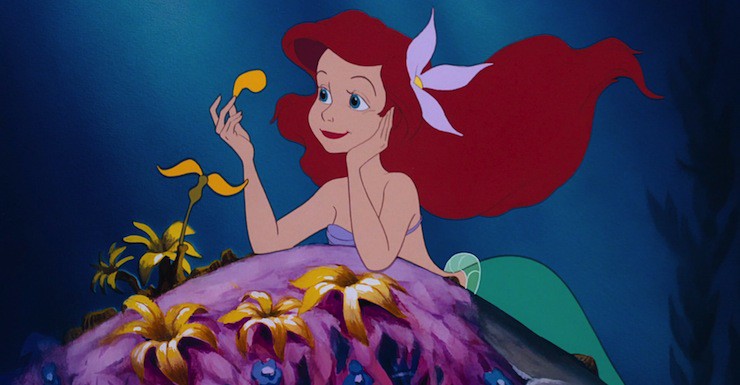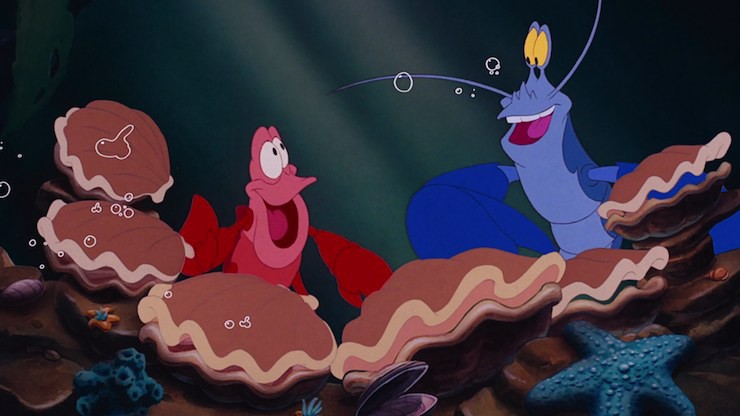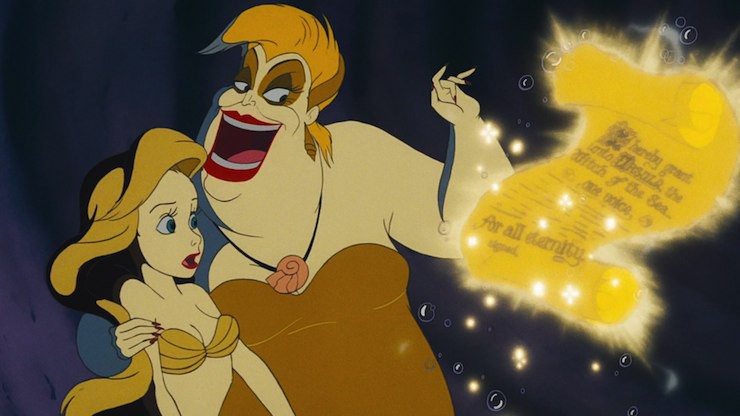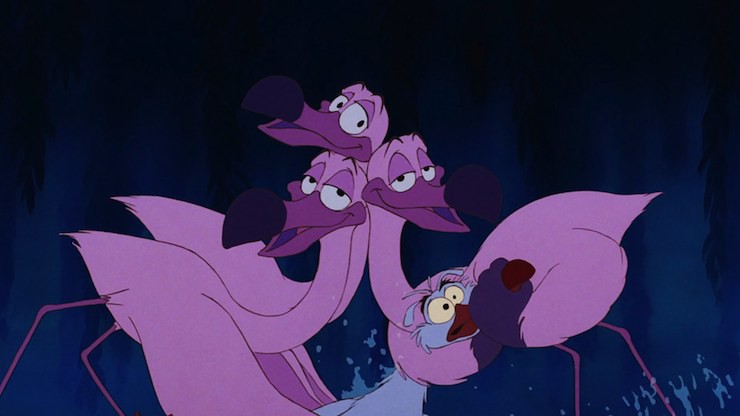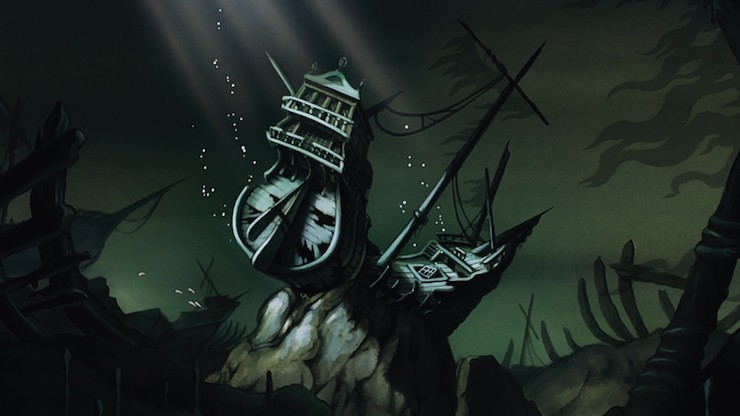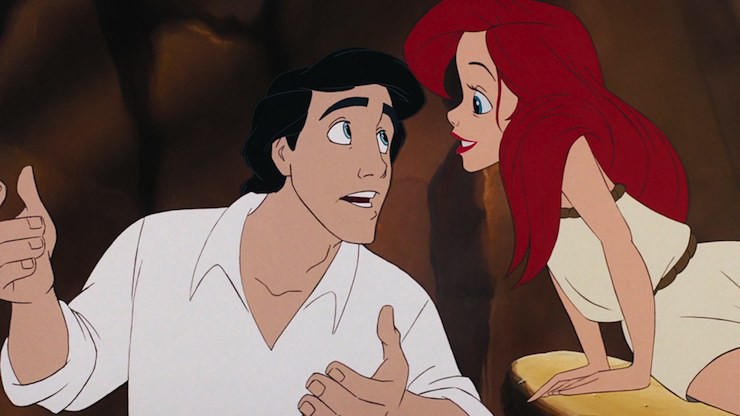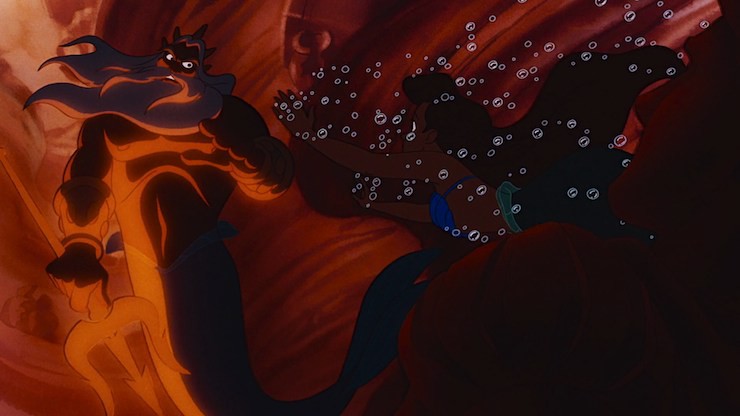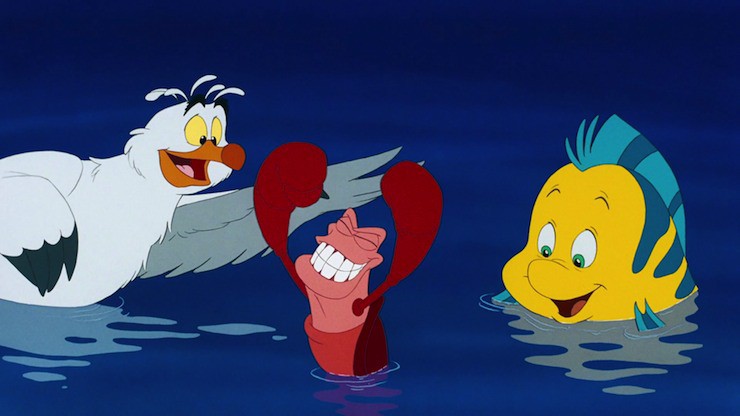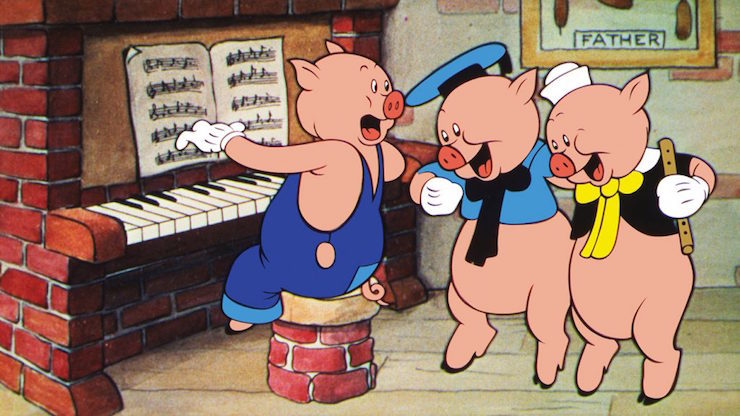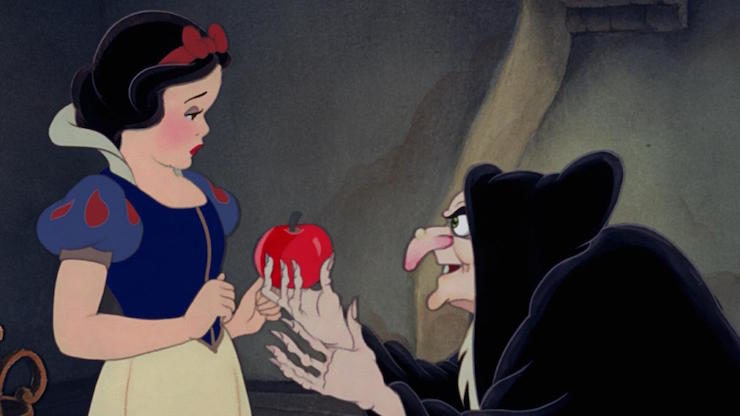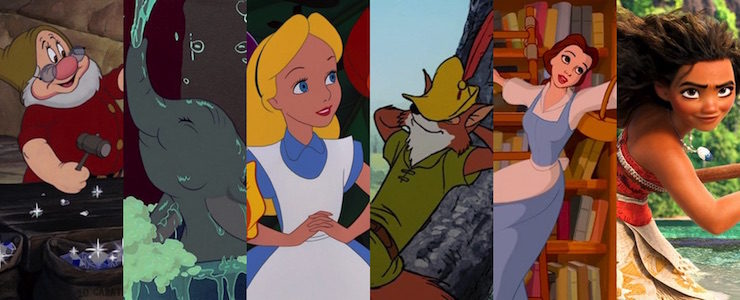As gloomy as most of the 1970s had been for Disney’s animation department, the 1980s were even worse. The Fox and the Hound had swiftly settled into obscurity; The Great Mouse Detective, though an improvement, had only done moderately well at the box office; and the trauma that had been The Black Cauldron still lingered in the animation walls. Still, Jeffery Katzenberg insisted that the studio return to producing one animated film per year. With cheerful, family friendly things. No matter how glum the animators felt.
As the decade drew to an end, however, two minor miracles happened that transformed the entire direction of Disney animation. First, Amblin Entertainment and Steven Spielberg agreed to come on board for Who Framed Roger Rabbit, invigorating both the film and general interest in animation, and convincing Katzenberg to loosen the budgets, just a little, for future films. And second, lyricist Howard Ashman, hired to do some work on one of the songs for Oliver and Company, and until then probably best known for a small thing called Little Shop of Horrors, just happened to wander by the animation studios and notice that they were working on a little thing about a mermaid.
Ashman had some ideas.
The rest is Disney history, mixed with legend.
Ashman wasn’t totally sold on one of the sidekicks—a major-domo with a British accent. Why not, he suggested, make the sidekick into a crab? Named, maybe, Sebastian? And then have the crab—just as a passing thought—do some calypso numbers?
Some really big calypso numbers?
And—Ashman started warming to his subject—not to denigrate what had happened in previous Disney films, and was happening just then in Oliver and Company—why have the action stop just to let characters sing? Why not—again, just a thought—use a Broadway/film musical format, where the songs advanced the characters and the plot?
For that matter—Ashman was excited now—why not turn the film into what was, basically, an animated Broadway musical?
In the end, Ashman and his musical partner, Alan Menken, became so involved—some later said obsessed—with the film that they became co-producers. Ashman, indeed, became so obsessed that even when he was diagnosed with AIDS midway through production, he told no one, instead focusing almost all of his energies on the film’s storyboarding and design. The process so enthralled him that he began pitching ideas for Aladdin while artists were still finishing the background art for The Little Mermaid. Menken, meanwhile, concentrated on the score.
The result: music that was far and away the best heard in a Disney animated film since at least The Jungle Book. Given that The Jungle Book had only two hit songs, and The Little Mermaid managed four, it arguably well outdid The Jungle Book in that respect. Even apart from the catchy tunes, the score had a lushness not heard since Sleeping Beauty, and before that Fantasia; we probably have to head all the way back to Pinocchio and Snow White to find another Disney score that combined catchy tunes with a lush score this well.
(Having said that, I can unfortunately testify that the music has quite a few disadvantages to anyone attempting to blog about the film shortly after watching it, since two things happen: one, you will inevitably terrify your cats by suddenly singing out POOR UNFORTUNATE SOULS, IN PAIN, IN NEED, or, even worse, find the words WHAT DO THEY GOT A LOT OF SAND? WE GOT A HOT CRUSTACEAN BAND! intruding right in the middle of a nice paragraph comparing previous Disney scores to The Little Mermaid. You have been warned.)
My favorite is probably “Poor Unfortunate Souls,” belted out by Pat Carroll with gusto, where Ursula cheerfully presents herself as a misunderstood, kindhearted sort just looking out for unfortunate little mermaids. Ok, so, it doesn’t exactly convince the horrified Flounder and Sebastian, who, I’m sorry to say, show no appreciation for the song at all, and I’m not sure that it exactly convinces audiences, either. But her argument does convince at least one person, Ariel, who responds by signing away her voice, and possibly her life and her soul. Bonus points to Ursula for managing to convey complete contempt for all human men while simultaneously convincing Ariel to sacrifice virtually everything to get one; it’s a masterpiece of manipulation.
But it’s not the only masterpiece. Only one song, “Daughters of Triton,” doesn’t really work—and since it’s meant to be fake, showy, overdone and all that, the not working, well, works. “Kiss the Girl” works both as a set piece and a plot point, and “Under the Sea”—well, “Under the Sea” shows us that Sebastian is perfectly capable of improvising an entire song—and getting an orchestra to play right along with him, something definitely needed to convince us that Sebastian isn’t just around to be fussy comic relief. The main song—”Part of Your World”—ties the film together; the tune is replayed again and again to remind us—as if we needed reminding—just what Ariel’s trying to accomplish here.
That was the glorious part. The bad part involved attempting to animate these songs. By their very nature, the elaborate calypso numbers—and even the throwaway song “Daughters of Triton”—required animators to animate multiple characters in one scene, something done for a few seconds here and there at the end of Who Framed Roger Rabbit, but otherwise something Disney had assiduously avoided for cost reasons since Sleeping Beauty (and before that, Bambi). “Under the Sea” and “Kiss the Girl” in particular caused animators fits, especially since both also had to incorporate visual jokes.
Another huge issue: a solid half of the film, including three of its biggest musical numbers, takes place underwater. By nature, objects seen through water look different than objects seen through air, and Disney needed to account for this visual different. Disney had animated underwater scenes before, of course, in Fantasia and Pinocchio—but those films had been animated decades before, on considerably more generous budgets. The underwater scenes in Fantasia and Pinocchio were also relatively brief, not giving animators for The Little Mermaid too many prior examples to study.
Also, the brief underwater scenes in Fantasia and Pinocchio had occurred in more or less similar lighting situations. The Little Mermaid had to animate settings as different as the brightly lit water just below the surface, the artificially lit palaces of Triton and Ursula, and the wrecked ship Ariel and Flounder explore towards the beginning of the film—a setting that also involved an attacking shark. To try to make this all look natural, the animators visited several aquariums and studied photos of underwater caves and waves.
(The ship, incidentally, apparently makes a later appearance in Frozen—a fan theory speculates that it’s the ship carrying Elsa and Anna’s doomed parents.)
Most of this, however, couldn’t be directly animated: a full 80% of the film eventually ended up needing effects work of some kind or another. The animators also used the still new, still experimental computer animation for some sequences, notably the opening shots of the ship coming over the sea. The time consuming, expensive effects and computer work is also, if you are wondering, one of the reasons why the film stops its narrative dead for a comedy scene where Chef Louis (voiced by veteran actor Rene Auberjonois, at the time best known for Benson) wildly chases Sebastian around the kitchen: sure, it’s great slapstick, but more critically, it didn’t need a lot of effects work. Nor did some of the scenes with Ariel and Eric travelling around, or in the castle: it’s sort of a miracle that we didn’t get more of that and fewer underwater sequences.
The study of underwater light and the effects work paid off: The Little Mermaid was the best looking animated feature Disney had released since at least The Rescuers, and before that, Sleeping Beauty. Critics hailed the film as a return to the days of Disney greatness—that is, the films where Walt Disney himself was in charge.
That particular critical argument may be arguable: at least three earlier Disney films—Sleeping Beauty, Fantasia and Pinocchio—contained more elaborate, detailed, complicated animation. Having said that, the animation and background art in The Little Mermaid is, at least on a technical level, better than the animation of Cinderella or The Jungle Book, and certainly better than all of the anthology films supervised by Walt Disney. At the very least, The Little Mermaid was the first post-Walt Disney film that could be ranked next to the classics.
What made The Little Mermaid stand out, however, was not just the animation, or the songs, but the characters, starting with the protagonist, Ariel. In a notable switch from Disney’s three previous kindhearted, pretty, yet mostly bland princesses, Ariel is a rebellious, almost bratty teenager with a fierce personality. Snow White, Cinderella and Aurora/Rose all obeyed the rules, even if doing so left them in tears; Snow White even enforced them. Ariel doesn’t. She forgets a major concert that she absolutely, positively, completely had to be at because, well, she got distracted. This may not exactly be admirable, but it’s entirely sympathetic, as is her realization that she has deeply screwed up, followed by her “Oh, my father’s going to kill me,” made even more sympathetic when we later see just how much power her father wields. Later, she rebels more directly, heading to her father’s sworn enemy—and coming close to making him lose almost everything as a result. She’s the first Disney princess allowed to screw up, a lot, and if some of those mistakes—like twirling her hair with a fork—come from ignorance—others come from her inner fire. Ariel doesn’t let plot just happen to her: she drives it, and that makes her interesting to watch.
And, yes, she gets to rescue the prince and fight back against a sea witch.
Ariel also has the distinction of being the first Disney princess to get to spend actual time with her prince. Ok, not all that much time—Eric only has three days to kiss the girl, after all. But that’s already more time than the previous three princesses had. And, fast paced though this romance is, it does have a stronger foundation than the other three as well. Granted, on Ariel’s side, her initial infatuation does partly stem from her obsession with humans, and partly from being an impetuous sixteen year old. But she also does have the chance to observe Eric interacting with the other sailors on the ship, and trying to be heroic during the shipwreck. Contrast that with Snow White, who only gets to observe her prince looking over a wall, or Cinderella and Aurora, who only get to dance with their princes—not see them in action. Ariel then gets to spends two days with him. Granted, during most of this time, Eric is thinking about another girl—the girl who saved him from the shipwreck. Who also happens to be Ariel, but Eric doesn’t know this, because Eric is not very bright. And because although Ariel is literate enough to sign contracts that can doom her entire life and lead to the destruction of an underwater sea kingdom, she’s apparently not literate enough to write HI I AM THE GIRL WHO SAVED YOU FROM THE SHIPWRECK. I SACRIFICED MY VOICE FOR YOU KISS ME NOW PLEASE on palace stationery.
But at least they spent time together.
Eric, alas, is yet another prince in a long line of colorless, bland Disney princes. About all we know about him is that he likes dogs (good), boats (also good), is not all that good at faking gratitude when he’s given a statue he doesn’t want (mixed), is avoiding marriage even though the entire kingdom wants him to get married and, presumably, have cute little babies (understandable, and in keeping with Cinderella’s Prince Charming), is easily enchanted (also understandable), is willing to escort a voiceless girl around his kingdom and show her a puppet show (good), and is terrible at recognizing faces (needed for the plot). And, like Ariel, Eric resists the plans that well-intentioned elders have for him, which isn’t much, but that does bode well for their future relationship.
And that’s pretty much it for Eric. But if The Little Mermaid doesn’t provide us with much of a prince charming, we do get, in opposition to Ariel, one of Disney’s most splendid villains:
Ursula.
(She’s great enough to deserve her own line in this post.)
I already mentioned her song, of course, but three other things make Ursula great. One, she’s hilarious. Two, in her own opinion, at least, she is the most pathetic, put upon, mistreated villain in Disney history. And I can totally see what she means. I mean, just look at her, wasting away to practically nothing. Ursula’s depression about weight loss and joyous acceptance of her own grand size is another delight, even if this is slightly undercut by her later decision to seduce Eric in the form of a svelte charmer—though to be fair, that’s partly because to pull off that stunt, Ursula needs to have some physical resemblance to Ariel. And—in her own mind, at least, she’s fully justified in pulling off that stunt, fully believing that she would make a better ruler of the underseas kingdom than Triton. Certainly, part of her motive is revenge—but that’s not all of it, which is exactly what makes her so dangerous.
And three, by her own standards, Ursula plays scrupulously fair. Ok, yes, she sorta completely fails to inform Ariel that this is all part of her plan to take over Triton’s kingdom and from there, the world, and she only gives Ariel three days to seduce Eric into that kiss. And sure, Ursula has her minions interrupt a perfectly good calypso song urging Eric to go on and kiss the girl just after the flamingos had finally managed to silence Scuttle’s not exactly romantic warblings. The sea witch just has no appreciation for great music if she’s not singing it, I tell you.
But if their agreement is rather one sided, Ursula does make sure Ariel is fully aware of the conditions, even, at one point, telling Ariel, “Now, this is important,” ensuring that Ariel is fully aware of the conditions. And, as it turns out, Ursula is completely right to have a certain, shall we say, contempt for how easily men—well, ok, Eric—can be swayed by body language. Three days is enough for Eric to fall in love—after all, this isn’t exactly the first time they’ve met. Indeed, Eric’s almost ready to kiss her by the evening of the second day. It’s a difficult challenge, as in all fairy tales, but it’s not an impossible one.
(And to repeat my earlier point, Ariel, unlike Andersen’s little mermaid, does have the option of grabbing a piece of paper and telling Eric about that first meeting, making the challenge almost easy. This apparently doesn’t cross her mind at all, because, Ariel, not great with the long term thinking).
And Ursula fully admits that not all of her customers have been fully satisfied—even if, she insists, “On the whole, I’ve been a saint—to those POOR UNFORTUNATE SOULS!” Given that the poor unfortunate souls in question are quivering just below, terrifying poor Flounder and Sebastian, I can’t exactly blame Ursula for Ariel’s complete failure to see HELLO POOR UNFORTUNATE SOULS RIGHT IN FRONT OF HER. (Again. Ariel. Teenager. Not great with the long term thinking.)
Adding to the complexity: Ursula is not after Ariel, but Triton—and the few scenes we do get of Triton suggest that Ursula’s not completely wrong here, and may even have a legitimate grievance. After all, when Triton discovers Ariel playing with the statue of Eric, he doesn’t just destroy the statue, but all of the objects Ariel has carefully collected—at some risk to herself—over the years. It’s an overreaction that leaves Ariel heartbroken, too upset to even talk to her friends. This in turn means that Ursula isn’t setting a trap for Ariel—she’s just taking advantage of her opponents’ weaknesses and flaws. She’s intelligent, manipulative, and not the only person in this film with a temper. Indeed, she even seems to be a bit better at controlling that temper than several other characters in this film. And that makes her dangerous—and great.
Also great: the three comic sidekicks—Flounder, Sebastian and Scuttle, the last voiced by legendary comedian Buddy Hackett. What makes them work, beyond the comedy, is that all three of them help to take Ursula down—Flounder by dragging Ariel out to the ship; Scuttle by disrupting the wedding; and Sebastian by summoning Triton. The film takes time, too, to set up that all of them have the ability to do this: I don’t know, exactly, how Flounder got that statue of Eric over to Ariel’s collection, but it shows he can pull things far heavier than he is through water.
All of this—animation, music, characters and comedy—made The Little Mermaid an unquestioned hit, both in regular and video release. It eventually spawned its own franchise which included an animated television show (Disney’s The Little Mermaid, which ran for a total of three seasons and 31 episodes, and still appears on The Disney Channel; its most memorable element is probably Mark Hamill’s voicing of Hans Christian Andersen); one terrible direct to video sequel (The Little Mermaid II: Return to the Sea in 2000); and one not quite as terrible direct to video prequel (The Little Mermaid: Ariel’s Beginning in 2008). Along with several other later Disney animated films, The Little Mermaid was adapted into a relatively successful Broadway show, which continues to tour internationally and appear—excerpted—as part of Disney Cruise Line’s regular entertainment. Music from The Little Mermaid is regularly performed at all Disney theme parks, all of which also have either a The Little Mermaid attraction or regular visits from Ariel—sometimes as part of the Disney Princess franchise. And, naturally enough, “Under the Sea,” became a virtual theme song for Disney Cruise Line. Ariel joined the Disney Princess franchise the moment it was created, and if stores at Walt Disney World remain any guide, she’s still one of the most popular, selling merchandise ranging from clothing to toys to dolls to trading pins to mugs and more.
For the immediate future, however, the most important impact of The Little Mermaid was simple: Disney animation was back in all its glory. But before exploring that, Disney Animation wanted to test out some more of that computer animation stuff on the planned sequel to their one successful film in the hell that had been years between Jungle Book and The Little Mermaid.
The Rescuers Down Under, coming up next.
(Housekeeping note: since the textual source for the main characters in The Rescuers was discussed earlier in this Read-watch, we’re skipping the rest of Margery Sharp’s books and heading straight to the film, mostly included in this Read-Watch because, on a technical level, it was the single most important film for Disney Animation since One Hundred and One Dalmatians.)
Mari Ness lives in central Florida.










